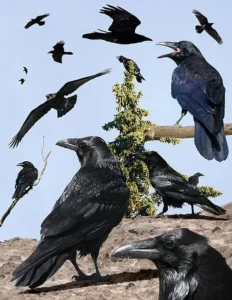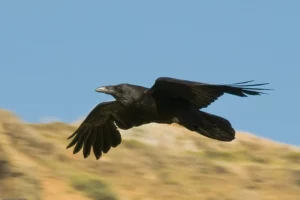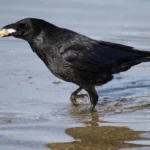Despite sharing the same genus and family as crows, ravens are not as social as crows. So, it would be interesting to learn whether these birds reside in groups.
Ravens are often found to form groups. These bird flocks do come together for some very specific reasons, though. Raven groups are most common in the winter when these birds hunt together. Ravens form groups for a variety of other purposes as well, including protecting their area and their young ones.
It is not just sufficient to learn that ravens form a group, as several other interesting facts are associated with their group formation. Hence, in this post, we will discuss all those facts exhaustively and dig deeper to unearth the whats, hows, and whys behind “ravens forming groups.”
Why do ravens group together?
Although they frequently fly alone, ravens can also migrate in couples or flocks when they are young. But hold on! Why do ravens gather in flocks or groups?
Ravens typically gather in groups to eat the same meal. In other words, these black birds congregate to eat when the food is concentrated in one place. Additionally, throughout the winter, flocks of common ravens may assemble to feed during the day while resting at night.

Additionally, did you know that juvenile ravens will join a group if they see a large carcass being devoured by adult ravens?
Being “protective” is another reason why ravens might congregate. Even though a few predators target ravens, these birds are incredibly intelligent. As a result, they frequently reside in groups to ensure their safety and security.
You should also be aware that they support one another while cohabitating. So, it is not wrong to state that each raven is supported by its fellow members and the group.
What would you call a group of ravens?
So, you learned that ravens often group for different purposes. But when you see a group of ravens, what would you call it?
“Unkindness” is a term used to describe a group of ravens. However, this is one of many names for a group of ravens. Other names for a gathering of ravens include “congress” and “conspiracy.”
You may already be aware that ravens devour the meat of deceased animals because they are carnivores. The term “unkindness” may therefore make sense.
Note: Did you know a group of young male ravens can be called “Mobile Discotheque?”
What are the incorrect names given to a group of ravens?

Copetersen (CC BY-SA 3.0)
By now, you know the names a group of ravens called. But have you ever heard people call these groups by any other names? Are all those names correct?
Only some of the names given to a group of ravens are correct. Here are a few unusual names by which raven groups are generally called. They may appear funny, but they are inaccurate.
- Black army
- Murder of crows
- Big Blackbird
- Bundle of ravens
- Teams of ravens
- Too many ravens
When do ravens gather in large groups?
Ravens live in large groups sometimes. In fact, these birds form both large and small groups. The larger group of ravens is known as the “flock.” These flocks are formed, especially during winter, to forage foods. During the rest of the years, ravens prefer to stay in pairs or smaller groups.
Do ravens experience stress from living in a group?

The existence of a group of birds does not necessarily imply cohesion. So, does being in a group cause stress for ravens?
Stress is a common problem for ravens living in a group. Ravens in a group face competitions. Fights about who will lead the group and serve as its “alpha” frequently break out. This is so because higher-ranked ravens have better access to food and other resources, and other ravens obey them.
Most conflicts involve individuals of the same gender, and young ravens are found with high-stress levels.
Are ravens protective?
Ravens are known to be protective. When guarding their area and their young, they act protectively. However, these birds can become more aggressive to ward off perceived hazards.
Not only do people come under the wrath of protecting ravens, but also other predatory birds and animals. Occasionally, humans who approach a raven nest are attacked. However, they will rarely sustain significant damage.
Summary
By this point, you are aware that ravens form social groups. For example, in the winter, they may congregate in flocks to hunt for food while resting at night. Also, the larger groups frequently include higher-ranked ravens who serve as the group’s leaders.




